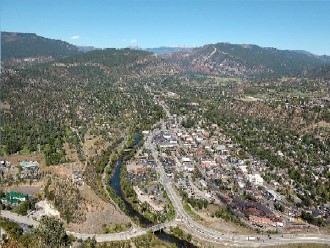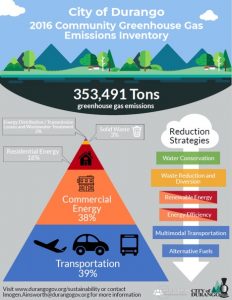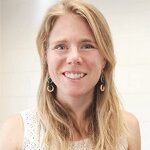The Challenge
An outdated greenhouse gas inventory
Following an initial county-wide greenhouse gas inventory completed in 2008 using 2005 data, the team was challenged to create an updated greenhouse gas inventory for the City of Durango. The objective was to create an inventory using current best-practice methodologies that could be used to establish priorities for emissions reduction and be relatively easily repeated in future years to benchmark progress.
The Results
A community-wide GHG inventory and strengthened relationships
In addition to fostering lasting relationships with local scientists and Fort Lewis College, this project enabled the City of Durango to complete a community-wide GHG inventory without the expense of hiring external consultants.
Through this project, the team delivered the following outputs:
- City of Durango Community GHG Inventory in ClearPath
- Public-facing report providing a summary and methodology of the inventory. The report also provides examples of existing or potential strategies to reduce emissions in each sector. The report is currently in draft form. Once finalized it will be shared with Durango City Council and the public as well as used to inform the development of goals and strategies for emissions reduction.
Project Overview
Durango is a small city in the southwestern corner of Colorado and is home to close to 19,000 people—the most populous city in La Plata County. The city was initially settled to serve the San Juan mining district and while some oil and gas development remains in the surrounding county, tourism is now the dominant industry in Durango. An historic downtown and railroad, extensive year-round recreation opportunities and proximity to archaeological sites including Mesa Verde National Park and Chimney Rock National Monument, draw thousands of visitors to Durango every year.
In 2015, Durango City Council adopted a Municipal Sustainability Action Plan. In 2017, the City attained certification under the STAR Communities program. Durango is also a member of the Colorado Compact of Communities, a coalition of cities and towns working together to scale up and advance climate action planning. Durango City Council identified ‘creating a higher focus on climate and sustainability’ as one of its top priorities and is committed to taking proactive steps to measure and curb its greenhouse gas (GHG) emissions. Many Durango residents have expressed support for city-wide sustainability initiatives.
In 2008, a baseline GHG inventory was conducted for La Plata County using data collected in 2005. In the years since inventory was conducted, the City has scaled up its sustainability efforts for both internal operations and in the wider community. However, no action has been taken to update the 2008 inventory or benchmark progress on emissions reduction. The city is now looking to update the inventory at the city-scale using the most recent data available. The new inventory will be used to set priorities for future actions to reduce GHG emissions throughout the city.


PROJECT SPONSOR

Project Team



About Us
The Community Science Exchange is a platform led by a coalition of partner societies, launched for elevating, sharing, and expanding the reach of science performed by, for, and with communities.
Contact
communitysci@agu.org
